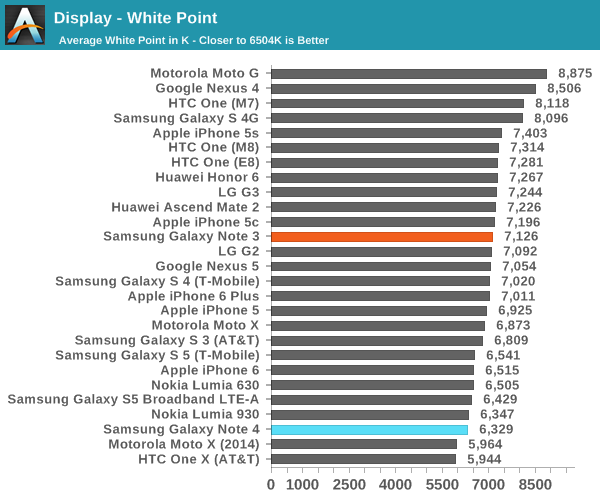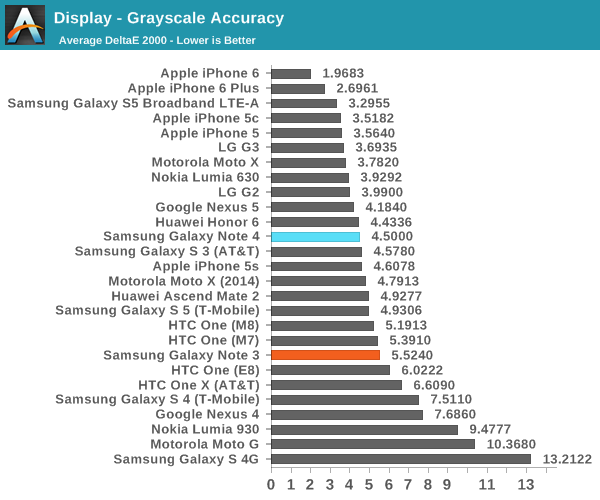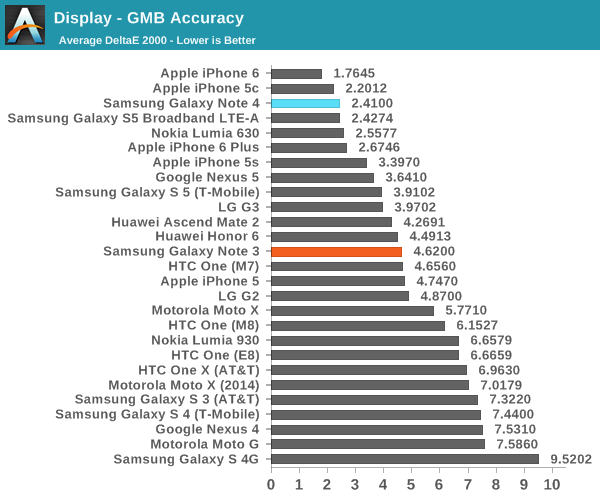The Samsung Galaxy Note 4 Review
by Joshua Ho on October 15, 2014 9:00 AM EST- Posted in
- Smartphones
- Samsung
- Android
- Mobile
- Galaxy Note 4
Display
With the advent of the modern smartphone, the display became one of the most important aspects of the entire experience as it was the only method of interacting with the device. To this end, Samsung has equipped the Galaxy Note 4 with their latest generation AMOLED panel, which has a higher resolution 1440p display, although this is achieved with a PenTile subpixel layout that makes total subpixel density lower than a conventional RGB stripe, so true subpixel density increases around 20% when compared to an RGB stripe 1080p panel. For reference, going from an RGB stripe 1080p panel to a 1440p panel of the same subpixel stripe would have a density increase closer to 80%.
In practice, the visible resolution varies somewhere between the “worst case” where the eye can see the true subpixel density and the best case where the display appears to be an RGB stripe 1440p display. If I look closely it’s still possible to see a fringing patterns in certain cases. Other than these minor cases, the Galaxy Note 4’s display has more than enough resolution for a smartphone use case. This is noticeably better than what I see with the iPhone 6 Plus, although in casual use it’s unlikely that these resolution differences will actually matter in most cases. I definitely think that there will be a visible difference for VR, although even the Galaxy Note 4’s display lacks sufficient resolution to have a “perfect” display in that scenario.
However, resolution is a relatively simple metric to look at. In order to better test the display we must look at other key metrics. In order to do this, we turn to SpectraCal’s CalMAN 5, along with a spectrophotometer for accurate color measurements.

While relatively simple, brightness and contrast are quite important as a display that’s dim or low in contrast will appear to be quite poor. In terms of brightness, we see that Samsung continues to maintain relatively high peak luminance, and a massive improvement when compared to previous generation AMOLED displays. While the normal peak brightness is a bit on the low side, as long as one uses auto-brightness the display’s “boost mode” will be able to activate and reach around 450 nits so in practice sunlight visibility should be more than acceptable. Contrast remains as incredible as it always is with AMOLED displays of this generation, although there still seems to be visible RC delay of some sort as there can be a purple trail effect when pixels transition from an unlit to lit state. I suspect this is mostly unavoidable, and is generally only visible at low brightness.


The next test we’ll look at is grayscale, which can suggest issues with overall tints in the display and issues with gamma. In this area, we see that the display is definitely quite good in overall gamma but unfortunately there’s a bit of a green tint here which causes a regression when compared to the Galaxy S5 LTE-A Broadband. This is really only visible on some certain percentages of gray but it would be an area where some improvement is needed.

While grayscale is one aspect of the display, it’s also important to look at color overall. One of the first tests for color is the saturation sweep, where the Note 4’s display performs admirably. At this point, there’s really not much to point out for improvement as the dE2000 average is low enough that one won’t notice any issues with color accuracy in Basic mode.

Similarly, the display does a fantastic job in the Gretag Macbeth ColorChecker. It should be possible to get a good idea of what a photo will look like on other displays and other similarly color-sensitive work on the Note 4. Samsung has also included other modes for those that want more vivid or otherwise more saturated color, which is of great benefit for those interested in such a color profile. The one potential issue here is that there is color shifting when altering viewing angles. In comparison to the Note 3, the Note 4 has a far better display. As-is, the state of AMOLED seems to be in a dead heat with LCD now as both seem to have their own trade-offs. However, we may soon see a shift as Samsung’s AMOLED becomes indisputably better than even the best LCDs.













195 Comments
View All Comments
KPOM - Wednesday, October 15, 2014 - link
It looks like they focused on the design and the display this time. I like the trend away from over saturated displays.mkozakewich - Wednesday, October 15, 2014 - link
No, they used movie mode. I didn't catch if they went there from where they were.Really, though, a larger gamut is a strength. All we need is for OEMs to create profiles so that we don't have the weird problems we had. They can create an sRGB profile, and an AdobeRGB profile, too. Then, when Android finally supports proper colour systems, they'll be able to introduce that immediately.
Wolfpup - Wednesday, October 15, 2014 - link
Disappointed that this isn't waterproof like the Galaxy S5 and S5 Active. I'd get the S5 just because of that.Samus - Wednesday, October 15, 2014 - link
Waterproof phones have never proven a big hit with consumers. The Kyocera Hydro and Galaxy S5 have a lot of inconvenient plugs and gaskets, with harder to press buttons. Then there is the added weight of the Active. There is always an Achilles heel to mil spec implementation.But it's good consumers have the option of waterproof devices, I just don't think the Note 4 being waterproof would be a compelling feature. I mean, if you drop the thing in the urinal its so big chances are the toilet cake would prop it up...and it's probably not on every sailors list of devices to have something so big.
Hrel - Wednesday, October 15, 2014 - link
There's also the fact that it's not very important to most people, if you'll be by water on a boat or something a $10 bag/case will do. Or hell, even a ziplock bag really. If it's a major concern for you then you're probably willing to spend the $100 on micro-sealing.petar_b - Wednesday, October 15, 2014 - link
I see waterproof feature it more like investment into protecting the investment rather than a feature. I would pay $100 on micro-sealing - just to be sure: if I am walking on the rain (following GPS), or phone accidentally falls in a puddle, or my kid accidentally drops it in the bath that it would survive. And protection bags are ugly, can't go on meeting with that, can't put on/off all the time. Additional frames to protect the screen or side sealing do reduce GPS signal; so no after market solutions.darkich - Wednesday, October 15, 2014 - link
I think the lack of water resistance is actually the result of the stylus slot. I could be wrong, but it seems somewhat logical that waterproofing such design would be difficultTams80 - Thursday, October 16, 2014 - link
I don't think so, unless the plastic of the stylus slot couldn't be impermeable (something to do with thickness?). It uses Wacom Penabled technology, so it should be possible (the Fujitsu Q584 has some water resistance with such a AD stylus).darkich - Wednesday, October 15, 2014 - link
I think the lack of water resistance is actually the result of the stylus slot. I could be wrong, but it seems somewhat logical that waterproofing such design would be difficultrobinthakur - Wednesday, October 15, 2014 - link
Disappointing really, not much wow factor here even if the materials have improved it just looks like a large Galaxy 5 with even less items of interest. Guess I will stay with the iPhone 6 plus.